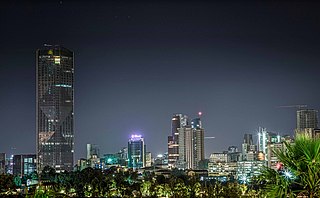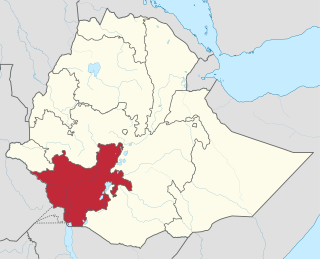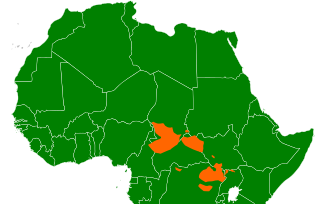
Addis Ababa is the capital and largest city of Ethiopia. In the 2007 census, the city's population was estimated to be 2,739,551 inhabitants. Addis Ababa is a highly developed and important cultural, artistic, financial and administrative center of Ethiopia. It is widely known as one of Africa's major capitals.

The Southern Nations, Nationalities, and Peoples' Region was a regional state in southwestern Ethiopia. It was formed from the merger of five kililoch, called Regions 7 to 11, following the regional council elections on 21 June 1992. Its government was based in Hawassa.

The Gurage are a Semitic-speaking ethnic group inhabiting Ethiopia. They inhabit the Gurage Zone and East Gurage Zone, a fertile, semi-mountainous region in Central Ethiopia Regional State, about 125 kilometers southwest of Addis Ababa, bordering the Awash River in the north, the Gibe River, a tributary of the Omo River, to the southwest, and Hora-Dambal in the east.
Anfillo is a Northern Omotic language spoken in western Ethiopia by a few hundred people. The term Anfillo is used to refer both to the language and the people found in a small community in the Anfillo woreda, part of the Mirab Welega Zone. The language is on the verge of extinction as it is spoken only by adults above the age of sixty. All younger generations have shifted to Western Oromo as of 2007.
Ethio-Semitic is a family of languages spoken in Ethiopia, Eritrea, and Sudan. They form the western branch of the South Semitic languages, itself a sub-branch of Semitic, part of the Afroasiatic language family.

Central Sudanic is a family of about sixty languages that have been included in the proposed Nilo-Saharan language family. Central Sudanic languages are spoken in the Central African Republic, Chad, Sudan, South Sudan, Uganda, Congo (DRC), Nigeria and Cameroon. They include the pygmy languages Efé and Asoa.
Sidama or Sidaamu Afoo is an Afro-Asiatic language belonging to the Highland East Cushitic branch of the Cushitic family. It is spoken in parts of southern Ethiopia by the Sidama people, particularly in the densely populated Sidama National Regional State (SNRS). Sidaamu Afoo is the ethnic autonym for the language, while Sidaminya is its name in Amharic. It is not known to have any specific dialects. The word order is typically SOV. Sidaama has over 100,000 L2 speakers. The literacy rate for L1 speakers is 1%-5%, while for L2 speakers it is 20%. In terms of its writing, Sidaama used an Ethiopic script up until 1993, from which point forward it has used a Latin script.
Prof. Olga Kapeliuk is an Israeli linguist.

The languages of Ethiopia include the official languages of Ethiopia, its national and regional languages, and a large number of minority languages, as well as foreign languages.

Kambaata is a Cushitic ethnic group in south-central Ethiopia, specifically in Kambaata Zone in Central Ethiopia Regional State. It is also known as Cambat, Kambata, Cambatta, Kambatta or Khambat by various historians and early explorers. The Kambaata people and Kambaatissa belongs to the East Highland Cushitic language family. Kambaata was first mentioned in the chronicles of Emperor Yeshaq I. Kambaata was "one of the southern kingdoms with well-established monarchical system...instituted in 16th century and operated without interruption until it ended at the last decade of ninetieth century" when it was incorporated by Emperor Menelik II. During this first period incorporation, Kambaata province was largely Christianized.
Hadiyya is the language of the Hadiya people of Ethiopia. Over 1.2 million speakers of Hadiyya, making it one of the ten major languages in Ethiopia. It is a Highland East Cushitic language of the Afroasiatic family. Most speakers live in the Hadiya Zone of the Southern Nations, Nationalities, and People's Region (SNNPR). The language has four recognized dialects—Leemo, Badawacho, Shashogo, and Sooro. These are mutually intelligible, with slight regional variations.

The Kunama language has been included in the proposed Nilo-Saharan language family, though it is distantly related to the other languages, if at all. Kunama is spoken by the Kunama people of the Gash-Barka Region in western Eritrea and just across the Ethiopian border. The language has several dialects including: Barka, Marda, Aimara, Odasa, Tika, Lakatakura, Sokodasa, Takazze-Setit and Tigray. Ilit and Bitama are not mutually intelligible and so may be considered distinct languages.
Hadiya, also spelled as Hadiyya, is an ethnic group native to Ethiopia in southern region who speak the Hadiyyisa language. According to a popular etymology, the name 'Hadiyya," means gift of god". it is mainly known for its Islamic influences in southern part of south shewa and west sharka A historical definition of the Hadiya people based on the old Hadiyya Sultanate included a number of Ethiopian ethnic groups currently known by other names. Currently, this historic entity is subdivided into a number of ethnonyms, partly with different languages and cultural affiliations. In his book "A History of the Hadiyya in Southern Ethiopia," Ulrich Braukämper reported that Leemo, Weexo-giira, Sooro, Shaashoogo, Baadawwaachcho, and Libido (Maraqo) Hadiyya, the Hadiyya proper. The term Hadiya specifically designates the Qabeena people. Other ethnic groups such as Siltʼe, Wulbareg, Azarnat, Barbare, Wuriro, Wolane and Gadabano profess that they're the seven Hadiya clans. Hadiya people were fully Muslims until invasion of menilik II in 19th century that caused massive forced conversion to Christianity and increasing Protestant missionaries in late 19s. Clans of Hadiya origin in Oromia, Sidama, Wolayta, Gurage, Tigray, and Afar were completely absorbed by these nations. They were initially all inhabitants of a single political entity, a sultanate, which in the four centuries following its break-up in the mid-16th century fragmented into separate ethnic groups.
Burji language is an Afro-Asiatic language spoken by the Burji people who reside in Ethiopia south of Lake Chamo. There are over 49,000 speakers in Ethiopia, and a further 36,900 speakers in Kenya. Burji belongs to the Highland East Cushitic group of the Cushitic branch of the Afro-Asiatic family.
Highland East Cushitic or Burji-Sidamo is a branch of the Afroasiatic language family spoken in south-central Ethiopia. They are often grouped with Lowland East Cushitic, Dullay, and Yaaku as East Cushitic. The most popular language is Sidama, with close to two million speakers.
Kambaata is a Highland East Cushitic language, part of the larger Afro-Asiatic family and spoken by the Kambaata people. Closely related varieties are Xambaaro, Alaba, and Qabeena (K'abeena), of which the latter two are sometimes divided as a separate Alaba language. The language has many verbal affixes. When these are affixed to verbal roots, there are a large amount of morphophonemic changes. The language has subject–object–verb order. The phonemes of Kambaata include five vowels, a set of ejectives, a retroflexed implosive, and glottal stop.
The Ethiopian language area is a hypothesized linguistic area that was first proposed by Charles A. Ferguson, who posited a number of phonological and morphosyntactic features that were found widely across Ethiopia and Eritrea, including the Ethio-Semitic, Cushitic and Omotic languages but not the Nilo-Saharan languages.
The Siltʼe people are an ethnic group in southern Ethiopia. They inhabit the Siltʼe Zone which is part of the Southern Nations, Nationalities and Peoples Region. Silt'e people speak the Siltʼe language, a Semitic language, which is closely related to the Harari language.
The Halaba people are an ethnic group inhabiting the central Ethiopian highlands. The Halaba claim to originate from the Arab cleric, Abadir who settled in Harar. In the middle ages, Halaba were part of the Hadiya state. In the 1400s, their Garad (chief) was in conflict with the Abyssinian monarch Zara Yaqob. They are mostly Muslims but there are also some Christians. A map of the region from 1628 shows a Kingdom of Halaba. They speak Halaba-Kʼabeena which is a member of the Highland East Cushitic languages within the Afroasiatic family. Sidi Mohammed the Garad of Hadiya is stated to be a forefather for the Halaba people.







